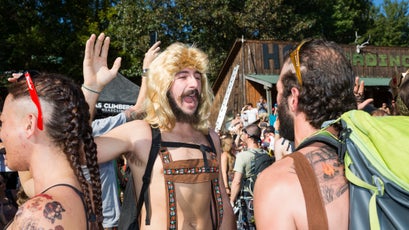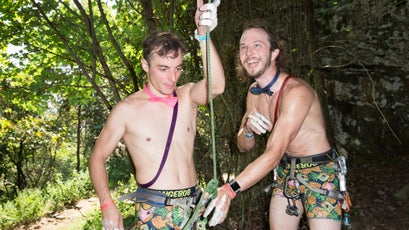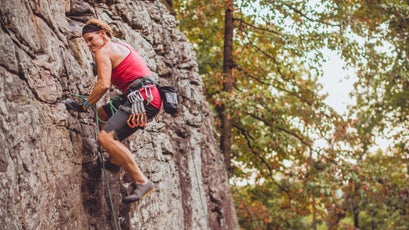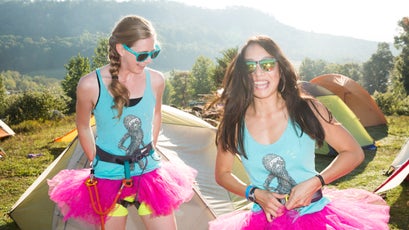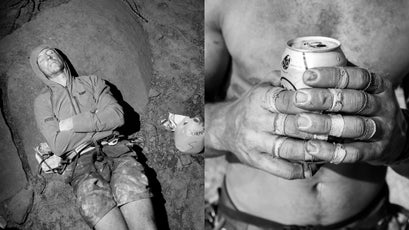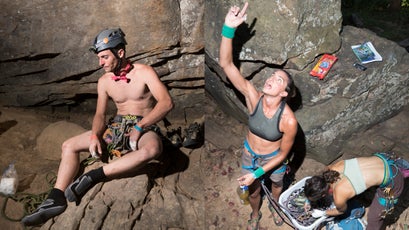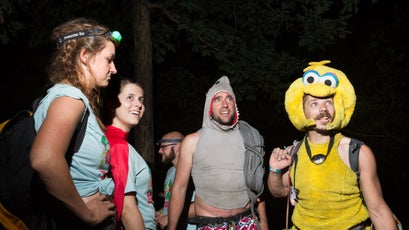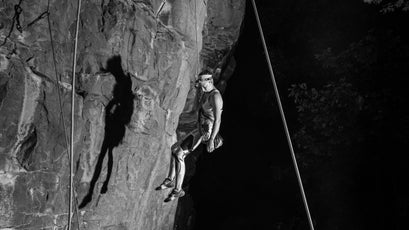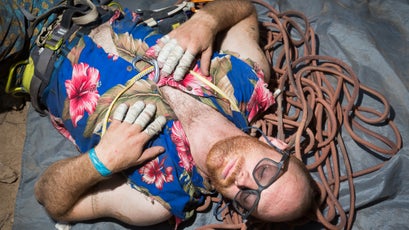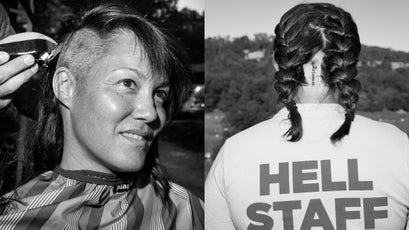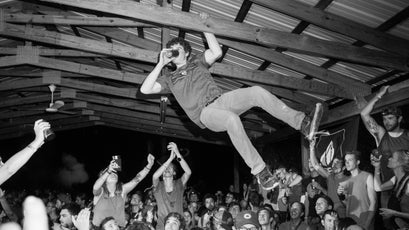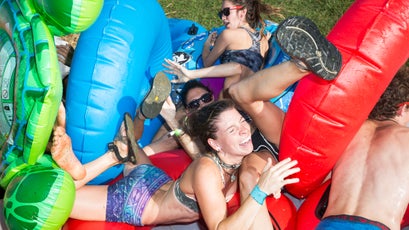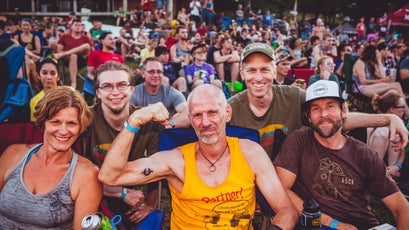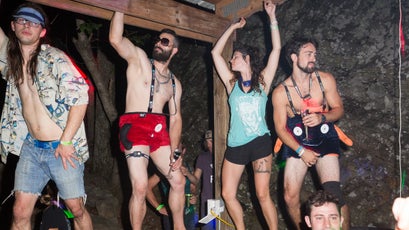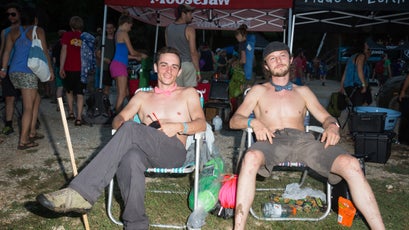The Wildest Party on Earth
The craziest rock-climbing event in the world happens annually in the Ozarks of Arkansas, in a u-shaped canyon with enough routes for 24 straight hours of nonstop ascents. They call it Horseshoe Hell, but don't be fooled: for outdoor athletes who love physical challenges with some partying thrown in, it's heaven.
New perk: Easily find new routes and hidden gems, upcoming running events, and more near you. Your weekly Local Running Newsletter has everything you need to lace up! .
It’s a muggy friday morning in the Ozarks. A leanly muscled man in cowboy boots, denim short-shorts, and a tank top that looks painted on is standing in the bed of a parked pickup, addressing a crowd of hundreds. âItâs hot, guys. Itâs really hot,â he says, using a microphone plugged into a beefy PA system. âWhat do we need to be doing today?â
âHydrating!â the crowd answers. âBeer!â someone yells.
Around him, there are nearly 300 rock climbers in costumed pairs: spandex stars-and-stripes wrestling singlets here, Kiss-Âinspired makeup and wigs there. A sweaty, oddly matched duo stands nearby, one in a Big Bird outfit and the other in a plush shark costume. The man in the pickup starts calling out the name that each team has chosen for itself. Dirty climbing puns predominate: Lichen Those Jugs So I Slab That Ass, Wham Bam Hand Jam, Tell Your Sister Thanks for the Loose Belay.
A reference to âs recent gear troublesâDoes Make My Rack Look Small?âgets a big laugh. So do Climb a Wall and Make Mexico Pay for It and First Auto-Belay Ascent of the Dawn Wall.
Every September, climbers from across the country gather here, at the âa private dude operation in northern Arkansas that also happens to be home to more than 400 estabÂlished routesâfor what has to be rock climbingâs wildest competition. The man with the mic is , the eventâs 39-year-old founder. In a few minutes, the 11th annual will begin.
From 10 a.m. today to 10 a.m. tomorrow, two-person teams will climb nonstopâor as close to nonstop as they can manageâÂracking up points for each route they complete. To be considered official finishers, each climber will have to send at least one route per hour; to automatically qualify for next year, each will have to do 100. Some teams will climb hundreds of pitches.
Chasteen hands the mic to another guy, , known around here as ÂGordo the Great. Heâs more animatedâa perÂformer, vibrating with energy. âWhat is up, you beautiful disgusting people?â he yells. ÂNearby, a smoke machine comes to life. âGet with your partner,â Gordo says. âYou know whatâs happening now.â He orders the crowd to repeat after him.
âPartner!â he yells. âPartner!â the crowd answers.
âRise and grind, the hour is upon us!â he says. âThe sun rises in the east!â In fact, the sun is already well above the canyon wall, beating down. The temperature is nearly 80 and going up. âNow we rise on walls of stone,â Gordo continues, striking a warrior pose. âNow we send till cows come home.â
âGive me 24 hours of ample belay. Give me 24 hours of heaven on earth. Give me 24 hours of hell!â
His voice rises in volume and Âdramatic effect, building to a finale. âToday we climb for glory.⊠When the sun rises again tomorrow, we arise like zombies from the bowels of night. We are lions in a field of lions. Letâs go!â
On âgo,â someone fires a shotgun and the climbers scatter. Most run across the ranchâs main gravel road and up a long open slope to a wooded area known as the North 40, a densely developed crag that hosts more than 120 routes, each just a few feet from the next. Others head down to the valley bottom and up again to the canyonâs East Side routes. AC/DCâs âThunderstruckâ pours out of the speakers. The hottest Hell yet is under way.
âs third Horseshoe Hell has not started auspiciously. He and his partner, , began their day on the East Side, hoping to knock out a few harder routes while they were still fresh. But things didnât go as planned. The sun lit up the rock, and Bennett, with sweat dripping into his eyes, took a couple of falls on a climb that was well within his ability. At one point, a climber just a few feet away disturbed a hornetâs nest. As the hornets boiled out, Bennett abandoned a draw and leapt off the wall, dropping away just in time, while the angry insects laid into the other man. Now, in the early afternoon, Bennett and Scarpella have crossed the canyon to climb on the edge of the North 40, in the shade, in an area known as the .
Horseshoe Canyon is (no surprise) horseshoe shaped. It sits in northern Arkansas, near the Ozark National Forest, east of Fayetteville, and not too far south of the Missouri state line. Itâs reachable via a narrow and winding stretch of Arkansas State Highway 74âfrom there a rough gravel road leads through a gap in the walls and down onto a grassy canyon floor.
On both sides of the valley, the floor curves up into wooded hills capped by knobby cliffs. Originally, the bare rock walls that line the ranch were beside the point. The owners who purchased the property in 1994 intended to open a typical dude ranch. But by the late nineties, as climbers began to develop the spotâa few locals had been hopping the fence to climb illicitly throughout the eightiesâthe owners hired people to start bolting routes. Today the ranch is home to more than 400 climbs alongside more than 100 boulder problems. Climbers can pay for day use or to camp out.
Horseshoe Hell is the ranchâs marquee climbing weekend, and Bennett and Scarpella, who go by the team name Cumbre o MuerteâSummit or Deathâare the defendÂing champions in the 24-hour competition. Both are sponsored Scarpa athletes; back home in the Denver area, they climb Âtogether often. Both are 31 and have been at it for about a decade. They showed up here in 2014 just to experience the event and get the lay of the land, but they came back in 2015 to win it.
This year theyâre looking for a new challenge. The day before the 24-hour Hell begins, thereâs a 12-hour competition. Participating in this phase can be a way for climbers to try a slightly less extreme endurance challenge, and it also serves as a qualifier for the 24. Bennett and Scarpella want to become the first team to win both the 12- and 24-hour competitions in the same year. Yesterday they climbed in the punishing sun for 12 hours straight. But as Bennett had pointed out then, âItâs so hard to thread the needleââthat is, to do just enough to win the 12 without completely destroying themselves for the 24.
One key to success, Scarpella says, is . The rock here is hard, dark sandstone, and their fingertips were raw and throbbing by the end of the 12-hour Hell. Last night, Scarpella applied a soothing tincture to his hands every time he woke up, and he felt better than expected when the 24 started. Now, three hours in, heâs attempting Something for Sofia, a 25-foot route graded at 5.11c that got the best of him twice yesterday. He manages the crux move, swinging out from under an overhanging roof, and sends it. Bennett lowers him to the ground.
âRedemption on the 5.11 rock climb,â Scarpella says wryly.
âThe 5.11, three-bolt rock climb,â Bennett reminds him.
Scarpella shakes his head. âWow.â
Theyâre ribbing themselves, of course. North American rock climbs are Âgraded using the , which ranges from 5.0âthe equivalent of an easy but steep uphill scrambleâto 5.15c, for the hardest routes in the world. Most of Horseshoe Canyonâs routes fall between 5.7 and 5.12; for Bennett and Scarpella, a 5.11 is pretty routine.
By 3 p.m., itâs a blazing 89 degrees with 43 percent humidity. Climbers sweat and suffer, burning raw fingertips on hot rock. The canyonâs upper sections are Âdensely Âwooded, threaded with goat paths, so climbs often start in the shade. Most routes are relaÂtively short single-pitch endeavors, but many take climbers above the tree line and into direct, relentless sunlight.
Bennett and Scarpella arenât the only team gunning for the never before achieved double victory in the 12 and 24. and âteam Those Guysâare after the same prize. Vabulas is a Âseven-time Horseshoe Hell veteran; Howell is aringer Vabulas recruited online. He specializes in long, high-mileage free-solo days, and heâs been known to have soloed naked. (You can find him on Vimeo, climbing without a rope and wearing nothing but a gray newsboy cap.) Today, like his partner, heâs climbing in SpongeBob boxer briefs and a bow tie.
Around 4 p.m., the two teams cross paths at a route known as Newton County Mentality. A howl to mark the hour rises somewhere in the canyon and travels around like a wave, climbers and volunteers and spectators joining in as it passes their section of the wall.
âHow are yâalls tips Âafter yesterday?â Vabulas asks.
âLike rhino skin,â Bennett says, deadpan. âLike pink baby rhino skin.â
24 Hours of Horseshoe Hell: The World’s Wildest Climbing Competition
Horseshoe Hell was born around a campfire. In the spring of 2006, Andy Chasteen was visiting the canyon to climb with friends. One night, with alcohol flowing, somebody suggested that they see how many routes they could do in ten hours straight. Horseshoe Canyon has so many routes, so close together, that they would hardly have to waste any time traversing from one to the next.
The group kept spitballing and finally settled on doing a full 24 hours. Chasteen pitched the ranchâs owner on the idea, set a date three or four months out, printed up flyers, and mailed them to climbing gyms in the region. He expected no more than 40 climbers to show up. He got 120.
Chasteen had been climbing for only a couple of years at that point and had Ânever been to a competition. He was a born-and-raised flatlanderâMissouri, Texas, Oklahomaâwho grew up playing basketball and other team sports, then got into climbing. These days he doesnât climb as much as he used to; heâs more into road bikes. But heâs an energetic and dediÂcated booster of Horseshoe Hell, which has thrived under his leadership.
Patagonia signed on as a title sponsor in 2008. Attendance has boomed, and thereâs now a lottery and a wait list to enter both the 12- and 24-hour versions. Most years thereâs a broken bone or two, but Horseshoe Hell has never seen a life-threatening fallâan impressive achievement considering the darkness, the potential for exhausted confusion, and the fact that some competitors donât wait until the legendary after-party to start drinking.
Some of climbingâs biggest stars have competedâincluding Alex Honnold and Tommy Caldwellâbraving sleep deprivation, sandpaper stone, heat, ticks, and chiggers. But Chasteen wants Horseshoe Hell to be as much a festival as a competition, open both to recreational climbers and pros. If you want to do 5.7 and 5.8 climbs for 24 hours, you can.
âIt doesnât matter if you can climb 5.14,â he says. âThat means nothing.â He compares Horseshoe Hell to an ultramarathon: you win by finishing.
Only five people have competed in Âevery Hell. Two of them are , who were friends and climbing partners for years before they married in 2012. Their continued presence is something of a miracle. In the heat of the afternoon, while Dick belays Natalie up a climb on Kindergarten Boulder, a route-Âriddled rock that sits on the forested slope below the main North 40 wall, he talks about an accident that changed his life.
In November 2014, Dick, then 65, was at his local climbing gym back home in NeÂvada. (During that yearâs Hell, he and NataÂlie sent 152 routes each, and Natalie set a new womenâs pitch-count record.) Dick was nearing the end of a 90-minute workout. Heâd already climbed every auto-belay 5.11 at the gym except one, a new 5.11+. He was climbing on auto-belay, working out the moves: climbing partway, coming down, climbing a little farther, coming down. At one point, he unclipped from the auto-belay device to get a drink of water, and when he came back to the wall, in the zone, he started up the route again. He was 30 feet off the floor, near the ceiling, when he fell. He didnât realize that heâd never reattached his auto-belay.
When Dick hit the deck, he couldnât feel anything from the neck down, but by the time he was loaded into an ambulance he could move his toes again. He never lost consciousness, didnât break any arms or legs, didnât do irreparable damage to his brain or spine. But he had a long recovery ahead, and a doctor told him he would never climb again.
Dick still sounds offended about that part. âHe made it sound like it was bowling,â he says. â âYou have to give up bowling.â â Heâs been climbing since 1974. Climbing is his favorite sport, his social network, and the reason he met Natalie. He was determined to make it back.
Dick was hospitalized for two months. Early on he couldnât squeeze a stress ball with his left hand, and the accident produced body pains that have never gone away. But somehow, just ten months after the fall, he was climbing at Horseshoe Hell again. He belayed Natalie to a new womenâs record, 160 routes climbed, and achieved the mandatory minimum to be considered an official finisher: 24 routes, one per hour, all 5.7âs.
This year heâs still in recovery, still aiming to send just 24 routes, but heâs upped the grades, putting some 5.8âs and 5.9âs in the mix. Thatâs partly so that he and Natalie donât have to roam around the crag in search of 5.7âs for him to climb. Efficiency matters: This year, Natalie hopes to blow up her own record. Her goal is 200 routes.
Dick lowers Natalie down from her latest climb, and she sees that her next target is occupied. âI donât want to wait,â she says, suggesting they go elsewhere. Dick is unruffled. âWeâll have to come back,â he says. âHydrate. We can take a breath here, dear.â She agrees to pause and take a rest. The sounds of trash talk drift over from anÂother pair of climbers nearby. âWhat are you, a 40-year-old woman?â one young man says to anÂother. Natalie laughs. Sheâs 51.
By 7 p.m., night is setting in. The cicadas start singing, loud enough to drown out the climbersâ small portable stereos. Volunteers stagger up and down the dung-strewn goat paths carrying massive coolers of water and Skratch drink mix on their backs. Headlamps come out, but the pace of climbing doesnât relent.
A young spectator, Chance, maybe nine or ten, finds Bennett and Scarpella climbing in the near darkness. Heâs from Springfield, Missouri, two hours away, and heâs here with his dad for the weekendâhis first outdoor climbing trip. (âWeâve got a lot of Chinese food placesâ in Springfield, he explains. âBut we donât have a lot of climbing places.â) Theyâll watch some of the competition today and climb at another crag a few miles away tomorrow.
âYouâre a great climber,â Chance tells Bennett after he touches down from his latest route.
âIâm a tired and sweaty climber,â Bennett says.
Chance is solemn. âSoon youâll be a delirious climber.â
They bump fists, and as the kid and his dad walk away, his voice carries back: âI got a fist bump from last yearâs winner!â
If Chance sticks with climbing, this trip will likely be his first of many to Horseshoe Canyon. While the competition attracts athletes from the Âusual placesâBoulder, the Bay Areaâit also draws heavily on the climbing communities in this Âregion. For people in Oklahoma, Missouri, Kansas, and Arkansas, Horseshoe Canyon is a localsâ crag, a spot to grow up on and return to. Some of the volunteers were raised in the area, left for work or school, and now fly back from all over to pitch in. Others just Ânever left.
As the night deepens, the pace starts to slow. Team Those Guys is struggling. Howell is fighting off nausea; Vabulasâs feet are white and shriveled from too many hours spent sweating in tight climbing shoes. Meanwhile, Bennett and Scarpella have headed over to another area of the ranch, Titanic Boulder, but things arenât looking good. Their muscles have begun to tingle and twinge, and their arms refuse to engage. Around 11 they decide to rest for a while. They strip off their harnesses and down a couple of beers. They figure their chances of winning the 24 are slipping away. Rumor has it that a pair of youngsters from Texas are climbing hard, sending routes so difficult that no oneâs ever bothered with them in the competition.
Natalie Dower, meanwhile, keeps methodÂically checking off climbs on her list, and Dick keeps notching his single climb per hour. With just over 11 hours left, Natalie has Âalready sent 138 routes.
Time crawls by in a blur of increasing pain and exhaustion. At 4 a.m., with six hours to go, thereâs a scramble of activity as each team completes a mandatory check-in, the event volunteers verifying that nobody is so thrashed that they become a danger to themselves or others. The temperature has dropped to a halfway-reasonable 67 degrees, but the humidity has climbed to 98 percent. The night is a swamp, the darkness punctured only by headlamps bobbing up and down the rock walls. The cicadas scream. Flying, biting insects charge into every small pool of light.
Bennett and Scarpella are still struggling. Theyâre back on the North 40, and theyâve scaled down their ambitions, easing off the 5.11âs and 5.12âs theyâd planned to do. Bennett says theyâre now just âpicking out 5.9âs and 5.10âs that look cool.â They know that they overdid it in the 12-hour competition, wrongly assuming theyâd be able to keep on charging in the 24.
A climber nearby is snoozing on his rope bag, and Bennett and ÂScarÂpella seem tempted to follow his lead. They sprawl out on a broad, gently sloped boulder, and Bennett pulls a T-shirt over his eyes. Another competitor, almost invisible on the wall above them, sings âThe Boxerâ softly to himself as he ascends. Within minutes the defending champions are asleep.
They pull themselves off the ground about 45 minutes later and try to get psyched for the Âfinal push. Itâs a limp, not a sprint, to the end. By the time daylight is filtering through the trees, most teams that havenât given up entirely are barely managing their minimum one route per hour. A large cluster of climbers, including Bennett and Scarpella, converge on the Kindergarten Boulder, where they bang out 5.5.âs and 5.6âs and count the hours and minutes until 10 a.m.
Bennett has gone full zombie. As a ragged howl advances around the crag to mark 9 a.m., heâs standing still, staring into the distance, tied in to his rope at the base of an easy route.
Another climber nearby is just a few pitches away from the 100 routes she needs to qualify for next year, and as she climbs her friends attempt to power her through. âYouâre a crusher! Youâre a crusher!â She tries to respond with a roar, but it comes out as more of a groan.
The minutes tick down. She hits 97 routes, 98, 99. Someone is cranking Rage Against the Machine on a portable stereo, and everyone seems to be experiencing one last surge of desperate energy.
Bennett snaps out of his trance and starts up the wall. When he reaches the anchors he tops out, climbing up and over onto the flat roof of the boulder, and looks around. Scarpella free-solos to ascend and reach his partner. Soon both men are standing on top of the boulder, arms raised in Âexhausted, ironic triumph. Up high theyâre in the Âdirect path of the sun, already blazing and heating the day into the eighties, and from the ground, in the shade of the boulder, they glow in haloed silhouette.
Bennett howls, pumps his fists, and yells âCumbre o Muerte!â Below him the survivors of Horseshoe Hell can only manage a halfhearted cheer.
After the competition formally ends with another shotgun blast, the climbers trickle down to the valley floor to turn in their scorecards. Some of the sponsor tents are handing out beers and margaritas, and despite the early hour the cold drinks get snapped up. Still, the crowd of competitors disperses quickly. People who have booked cabins or nearby hotel rooms shower and collapse into bed; others roll filthy and sweat-covered into hammocks and tents. They bandage their cuts and scrapes, apply skin tincture to the raw pads of their fingers, and check each other for ticks.
Late that afternoon, after a few hoursâ sleep, they regroup on the sloped grass in front of the ranchâs main lodge for the announcement of the winners. Chasteen and several volunteers are down below; prizes (swag, ropes, gear, plaques) are displayed on a hay bale. A slip-and-slide has been constructed during the afternoon. It runs from the top of the slope down to Chasteen and companyâto claim a prize, each winner will proceed to the top, take a shot of whiskey, and slide on down.
There are many ways to win at Horseshoe Hell. Prizes are awarded for most routes climbed, most points (based on route difficulty), and most vertical distance climbed. There are team and individual rankings, prizes for recreational and intermediate climbers, and prizes for the advanced and elite divisions. Prizes by grade, by gender. The ceremony goes on awhile.
Scarpella and Bennett are named the winners of the 12-hour competition, with a combined 40,770 pointsâfar more than most people rack up in the 24. They take their shots and slide down laughing, slamming into a hay bale at the bottom. But their 24-hour score, 41,350 points, is barely higher; itâs good for eighth place overall in the team standings. The young guns from Texas win the 24-hour, with 68,380 points accrued on 348 climbs. Their route count included Âforty-four 5.12âs, four of them 5.12d.
Howell and Vabulas had hoped to have a shot at prizes for route count and total distance. Despite their overnight struggles, they achieve their goals: they win for most routes climbed by a team in both the 12- and 24-hour competitions and for most distance climbed as a teamâmore than 1.5 vertical miles each.
Natalie Dower beats them bothâand every other climber in the 24-hour Âcompetitionâfor most routes climbed by an individÂual, with 206 to Vabulasâs and Howellâs 202 each. She also picks up prizes for most 5.7âs climbed, most trad routes climbed by a woman, most points for a female climber in the elite division, and most points racked up by a climber, of either gender, whoâs 45 or older. She hits the bottle and the slip-and-slide for each victory.
Dick Dower didnât win any prizes, but he set a quiet milestone of his own: for his 24th and final climb of the competition, he sent his first trad lead since the fall.
That evening the after-party gets rolling at a covered pavilion halfway up the hill to the North 40. Itâs basically a rave on a ranch: flashing lights, a DJ, a packed mass of sweaty revelers, many of them costumed and glow-sticked. Climbers jump and grind and scramble up to swing from the rafters, and the hot, damp air vibrates with bass from the speakers and energy from the crowd.
Down at the main lodge, a tattoo artist works through the night, inking a lineup of eager customers with the Horseshoe Hell logo. Many of the longtime volunteers and competitors who come back year after year get tattoos; the Dowers are among the first in line. Andy Chasteen sits on the sideline, on a large boulder in the shadows just outside the pavilion, supervisingâuntil eventually he gives in to loud demand to enter the fray. He dives and crowd-surfs above the climbersâ heads, getting passed from raw hand to raw hand.
In college football, fans like to say that they lost the game but won the party. At Horseshoe Hell, not everyone achieved their goals, climbed as hard or as long as they had hoped or imagined they might. But at least for tonight, everyone is feeling like a winner.



